Pride & passion - New Zealand Christmas trees
Nothing may compare to the pohutukawa or rata tree at your favourite holiday spot, but we can all enjoy a touch of that crimson splendour at home in the garden.
Pohutukawa and rata adorn our coastlines and forests from one tip of Aotearoa to the other. Both members of the plant genus Metrosideros, these majestic, slow growing trees can live over 1000 years.
Our coastal classic pohutukawa (Metrosideros excelsa) is queen of the windswept sea cliffs primarily of the North Island and its outlying islands. In climates too chilly for pohutukawa, her southern sisters take over, flaunting their brilliant orange-scarlet flowers from November to January. Southern rata (Metrosideros umbellata) thrives in high-rainfall forests of the South Island’s west coast and is common on Stewart? Island. Northern rata (Metrosideros robusta) is found mainly in the North Island and the north of the South Island.
Metrosideros means "iron-hearted". The timber is exceptionally hard and has a beautiful red colour. Maori used pohutukawa to make tools and in boat building. Dark red rata timber was prized for carving.
Pohutukawa have olive green leathery leaves, while rata leaves are dark green and glossy. While a rata tree will smother itself in bloom only once every few years, with minimal flowering during the in-between years, a pohutukawa will generally bloom every summer, once it reaches flowering age.
Tui, bellbird, kaka and other native birds are frequent visitors to both pohutukawa and rata flowers. The nectar is sought by honeybees which make our beautiful rata and pohutukawa honey. Sadly, the trees are also loved by possums, capable of killing a mature tree within a few years.
Metrosideros grow easily from seed and will freely interbreed in the wild. This leads to each tree having slightly different genes from its neighbour, a natural diversity that has in turn led to some excellent selections being developed for gardens. When nursery professionals discover a naturally occurring tree with superior traits (such as tidy shape, early flowering, bigger and brighter blooms, sheer volume of blooms or compact size, they are able to propagate it by cuttings. And hence we gardeners can choose a named variety that grows ‘true to type’ and meets our needs.
Adding to the selection are some close relatives of the rata and pohutukawa that exist throughout the South Pacific. Many of these look almost identical to our New Zealand species, but they will often bloom at different times of the year. Even if your garden is tiny, you can enjoy a splash of that crimson glory in your own backyard.
Here are some favourites. Not all are widely available in any particular season, but Go Gardening centres are always happy to help you find the right plant to suit your needs.
Trees
- Metrosideros ‘Vibrance’ – A pohutukawa from Coromandel selected for its compact growth and bright orange-red flowers.
- Metrosideros ‘Maori Princess’ – A tall and upright pohutukawa with deep crimson flowers. Makes a good shelterbelt or street tree.
- Metrosideros 'Scarlet Pimpernel' – A hardy pohutukawa although it needs protection from frost when young.
- Metrosideros 'Pink Lady' – A tall and straight pohutukawa with watermelon pink flowers.
- Metrosideros ‘Fire Mountain’ – A round spreading habit and orange-scarlet flowers.
- Metrosideros 'Maungapiko' – A natural hybrid featuring the extreme hardiness of the southern rata with the quicker growth of the pohutukawa.
- Metrosideros 'Mistral' – A natural hybrid of rata and pohutukawa from Great Barrier Island that flowers at an early age.
- Metrosideros ‘Aurea’ – A large pohutukawa with yellow flowers.
Large shrubs
- Metrosideros umbellata – A young Southern rata grows as a neat multi-branched shrub. While it becomes a tall forest tree in nature, this slow grower is useful in small gardens and a spectacular site in full bloom when it becomes a cloud of red.
- Metrosideros kermadecensis 'Variegata' – A small tree with compact green and cream leaves. Flowers are produced at an early age. It is extremely hardy to coastal conditions, a popular hedge and good in containers.
- Metrosideros 'Moon Maiden' – A compact yellow flowered form flowering in early summer.
- Metrosideros ‘Springfire’ – This popular Hawaiian cultivar has a compact rounded habit up to around 3m tall and wide, with prolific flowering in spring or early summer.
Small – medium shrubs
- Metrosideros ‘Tahiti’ – A Pacific Island variety perfect for small gardens and growing in containers. Beautiful all year round, it produces tidy mounding foliage that changes from olive to silvery grey, a beautiful contrast to the scarlet flowers and the conspicuous red buds. ‘Tahiti’ will bloom anytime from late autumn till spring. It needs a frost-free location.
- Metrosideros ‘Tahitian Sunset’ – A variegated form of Tahiti for an extra splash of colour.
- Metrosideros ‘Golden Dawn’ – Combines melon pink flowers with brightly variegated foliage. It may grow to 3m tall but is very happy being kept small with an annual trim after flowering - great in tubs.
Vines and groundcovers
- Metrosideros carminea – ‘Crimson rata vine’ can be grown as a climber or low shrub. Flowers smother the plant in late winter and spring. Fantastic over retaining walls.
- Metrosideros carminea ‘Carousel’ – A dwarf variegated shrub form of rata vine with glossy lime-green leaves with broad gold margins. Small carmine-red flowers appear in spring. Ideal as a groundcover or in a pot.
- Metrosideros carminea 'Ferris Wheel' – A small shrub with glossy dark green leaves and bright crimson spring. Great in a pot.
- Metrosideros perforata – ‘Akatea’ or ‘small white rata’ has glossy green leaves and small white flowers. In the wild it is the vine, but cutting grown plants taken from mature vines grow as a shrub.
- Metrosideros fulgens – Another of the NZ rata vines with orange to red flowers and a long winter flowering period.
In the garden ...
Few gardens have the space for a huge pohutukawa tree and their vigorous roots mean its important not to plant too close to buildings. However, because they respond well to pruning and trimming, pohutukawa are easily adapted to small spaces. They are fantastic as shelter hedging, or can trimmed as tidy silhouettes in a mixed planting. With annual trimming they can even be restrained in a large tub. By selectively removing branches, trees can be trained to a more open structure to maintain a view or let in more light.
Pohutukawa
- Fantastic for coastal gardens
- Wind tolerant
- Tolerate dry, impoverished soils
- Need protection from frost when young.
- Plant in well drained soil with full sun
Rata
- Slow growing
- Frost hardy
- Dry tolerant
- Wind tolerant
- Plant in well-drained soil with full sun
30-Nov-2014
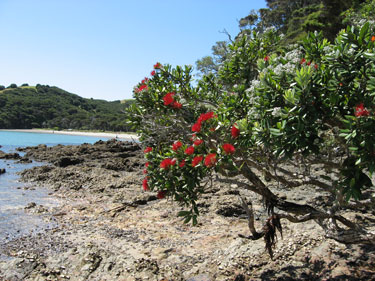
Pohutukawa
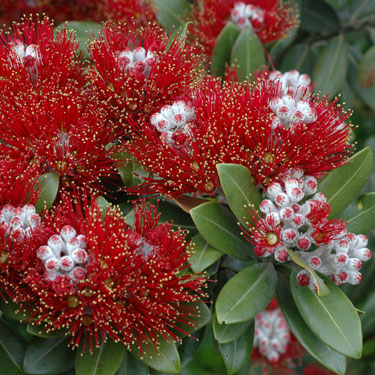
Metrosideros 'Vibrance'
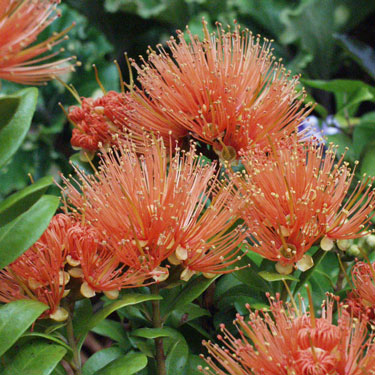
Metrosideros fulgens
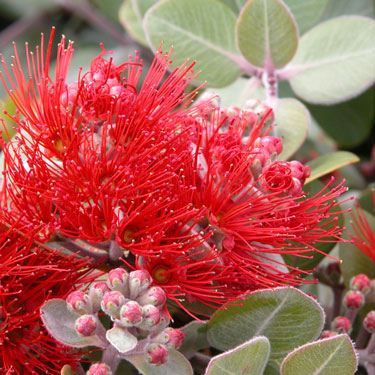
Metrosideros 'Tahiti'
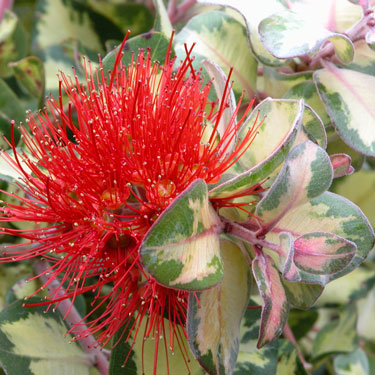
Metrosideros 'Tahitian Sunset'


